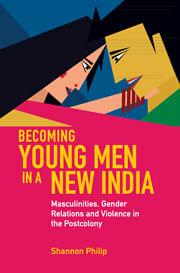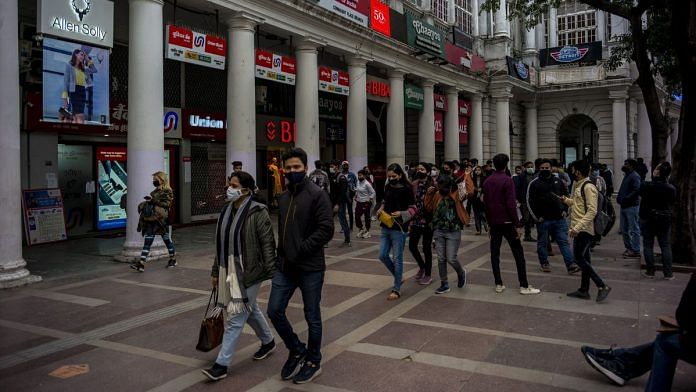The central aim of this book is to look at how gendered subjectivities and embodiments are constructed and performed for and by young men in this ‘new’ India and what consequences this has for gendering urban spaces, as well as India itself. With this central analytical aim, I primarily use the themes of roaming, grooming and protecting to present my ethnographic data and findings.
In Delhi it was common practice for my informants and me to go ‘roaming’, or ‘ghumne’, on an everyday basis after work or college and on weekends and holidays using public transport like metros and buses or sometimes in their family cars and bikes. For my informants, going ‘roaming’ is a pleasurable activity, which gives them space, freedom and a sense of authority away from their families and their homes. In the contemporary Indian context, Mazzarella (2004, 238) and Nisbett (2009, 72) use ideas of young men ‘roaming’ or going on trips for ‘boozing’ and ‘fagging’ (smoking) to describe activities of young men in their free time. Similarly, Lukose (2009) uses the concept of ‘karangan’, or literally ‘going around’, in the context of young men in Kerala who roam aimlessly for leisure and pleasure.
Having spent time with my informants ‘roaming’ around in the city of Delhi, I reveal how ‘roaming’ becomes an important activity that allows young men to come together as a homosocial group to create an inner social world for themselves, away from their families. Further, within this homosocial space, young men celebrate and partake in the pleasures of ‘new’ India through sex, drinking, smoking, shopping, horseplay, jokes and violence, which reveal to us the generational and gendered dynamics shaping the lives of young men in India today.
Amongst the Urban Smart Strivers, not every place is worthy of going ‘roaming’ in the city. By focusing on which specific sites and places are deemed worthy of going ‘roaming’, we can begin to see how young men view city spaces and lay claims on them. For example, when out ‘roaming’ with a young man called Kartik, we crossed a group of homes belonging to poor urban slum dwellers on our way to a shopping mall. Kartik pointed to these poor homes and explained to me that this was the ‘garbage’ (kachra) of India that had to be removed. For him, the urban slum has come to represent ‘garbage’ quite literally, whereas the shopping mall we went to afterwards is a mark of a ‘new’ India where he feels he rightly belongs.
Also read: #GenerationNowhere: India’s young are fighting an invisible epidemic, smartphone addiction
Young men like Kartik can move around various parts of the city without much care or concern. However, as I discovered, young men, curiously, have very strict views about where women can and cannot go in the city. When boarding the metro train, for example, Kartik is often annoyed at the fact that women enter the ‘general’ compartment of the train rather than going to the designated ‘women’s coach’ at the beginning of the train. This theme begins to show us the gendered understanding of spaces and infrastructures that young men like Kartik apply in the city and where they think women belong. Indeed, as feminist human geographers point out, such gendering of spaces is fundamentally dependent on the social relations that define the space and in turn order it (Massey 1994).
In this context, men’s narratives about ‘protecting’ women are also closely linked to the gendering of urban spaces in India. Focusing particularly on gendered violence, the Urban Smart Strivers think of the city of Delhi as an ‘unsafe’ place for women but the reason for its ‘unsafeness’ is always obscure and invisible. Likewise, I found that amongst middle-class young men, rape and aggression towards women are viewed as extraordinary acts of deviance by ‘evil’ or ‘deranged’ men. The role of their own masculine power, privilege and patriarchal entitlements is never brought into question. Rather, there is a counter-narrative of middle-class men being ‘protectors’ of women in the ‘naturally’ ‘unsafe’ city.
As Raj once explained to me, ‘I am a modern type of man, I care about women, they are in real danger in Delhi and so I am very protective about my girlfriend and my sisters, I never let them go out alone.’ Furthermore, what I found interesting was that in the context of great inequality in Indian cities, the demonising of the poor as ‘violent rapists’ is another middle-class trope that the Urban Smart Strivers strongly promoted. Raj, for example, explained to me that ‘poor men have the wrong mindset about women, they are uneducated and uncontrolled, so they do these bad things to women’. Such narratives were in contrast to the everyday realities of young men like Raj, who, whilst thinking of themselves as ‘protectors’ of women, would often try to ‘touch’ random women for ‘fun’ or give random women ‘flying kisses’ or make lewd and sexualised comments to women when out ‘roaming’ with their other male friends and me.
Also read: Unemployment and unlimited data pack — UP’s youth are neither angry nor idle
Finally, the theme of ‘grooming’ is also important analytically when thinking about young men, their ‘roaming’ and their many interactions with women. Whilst ‘roaming’ in Delhi, young men like Raj and Kartik constantly encountered new images and new representations of men through billboards, advertisements, Bollywood images and the wider public sphere of ‘new’ India. These images are dominated by representations of a commodified male body that is groomed, muscular, hairless, fair, active and distinctly heterosexual.
As I discovered, the encounter with these images shapes the ideas of what it means to be a ‘man’ and of having a ‘masculine’ body for the Urban Smart Strivers in profound ways. For young men like Raj, shaving their chest hair becomes an embodied sign of their ‘modernity’, closely aligned to their affective imaginaries and ethical inhabitations of ‘new’ India. Furthermore, young men like Raj think that their girlfriends and other women enjoy seeing their shaved, fair-skinned and muscular chests, so many of these grooming and consumption practices become sexualised and glamourised for them.
What is analytically important here is not the fact that men are taking an interest in grooming, which is a much older practice; rather, my focus is on what such types of gendered consumption, grooming practices and discourses tell us about the construction of masculine subjectivities in ‘new’ India and the changing gendered relationships between masculinities and femininities. I argue that by critically studying the grooming and aesthetic practices of young men, we can start to see the commodification of Indian masculinities and the various attempts to build a neoliberal masculine self of ‘new’ India. For young men then, these practices of ‘grooming’, ‘roaming’ and ‘protecting’ are not just practices of encounter but also participation that allow them chances to engage in elaborate rituals of seeing and being seen (Brosius 2010) as well as embodied celebrations of the ‘new’ masculine self.
As scholars demonstrate, grooming, presentation of the self and appropriate embodiment are crucial to presenting a ‘modern’ self-image for the youth and for establishing a neoliberal self within ‘new’ India (Brosius 2010; Nakassis 2013; Gooptu 2009). Indeed, empirical studies suggest that in India sales of men’s grooming products are now growing at twice the rates of women’s cosmetic products (Moss 2012, 53), and this is a trend that is mirrored across South Asia (Maycock 2017).
Similarly, I found that women were often forced to appropriately groom and consume in order to be deemed sexually desirable by the ‘grooming’ and ‘roaming’ young men. Urban Smart Strivers like Kartik, for example, would harshly judge women and humiliate and mock them if their consumption and grooming were not deemed appropriate. In this way, I found that ‘grooming’ and consumption become new sites on which masculine power and entitlement are demonstrated over women and other men too. Particularly when out roaming and on dates in the malls and shopping centres of ‘new’ India, young men and women have to show that they are appropriately groomed in order to mark their belonging within such spaces.
 This excerpt from ‘Becoming Young Men in a New India’ by Shannon Philip has been published with permission from Cambridge University Press.
This excerpt from ‘Becoming Young Men in a New India’ by Shannon Philip has been published with permission from Cambridge University Press.



